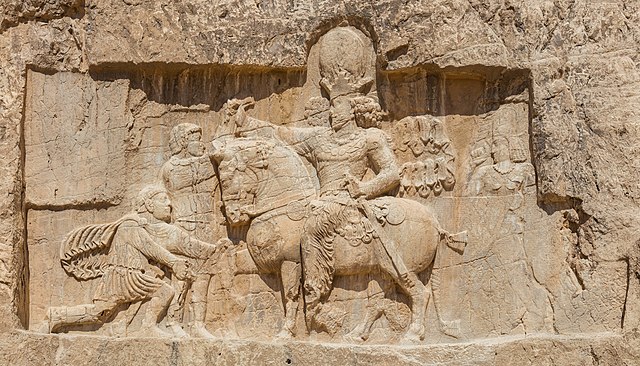Philip the Arab was Roman emperor from 244 to 249. He was born in Aurantis, Arabia, in a city situated in modern-day Syria. After the death of Gordian III in February 244, Philip, who had been Praetorian prefect, achieved power. He quickly negotiated peace with the Persian Sassanid Empire and returned to Rome to be confirmed by the Senate. During his reign, the city of Rome celebrated its millennium.
Bust, Hermitage Museum
Possible bust of Otacilia Severa, wife of Philip.
Rock-face relief at Naqsh-e Rostam of Shapur I (on horseback) with Philip and Valerian kneeling in surrender to the Persian king.
Coin of Severa. Legend: ΜΑΡ. ΩΤΑΚΙΛ. CEOΥHPAN CEB. / ZEYΓMATEΩN. Greek inscription in ACC for MAR. OTACIL. SEVERAM AVG. / (of) citizens of ZEVGMA.
The Hauran is a region that spans parts of southern Syria and northern Jordan. It is bound in the north by the Ghouta oasis, eastwards by the al-Safa field, to the south by Jordan's desert steppe and to the west by the Golan Heights. Traditionally, the Hauran consists of three subregions: the Nuqrah and Jaydur plains, the Jabal al-Druze massif, and the Lajat volcanic field. The population of the Hauran is largely Arab, but religiously heterogeneous; most inhabitants of the plains are Sunni Muslims belonging to large agrarian clans, while Druze form the majority in the eponymous Jabal al-Druze and a significant Greek Orthodox and Greek Catholic minority inhabit the western foothills of Jabal al-Druze. The region's largest towns are Daraa, al-Ramtha and al-Suwayda.
The Tell al-Hara volcanic cone in the Jaydur region of the Hauran plain, as seen from the Golan Heights to the west
The land of the Hauran plain is arable, consisting of basalt-derived soil, while the Lajat (pictured) has stony ground and scarce vegetation
The highest point of the Jabal Hauran (pictured) is over 1,800 meters above sea level
The Roman amphitheater of Bosra








